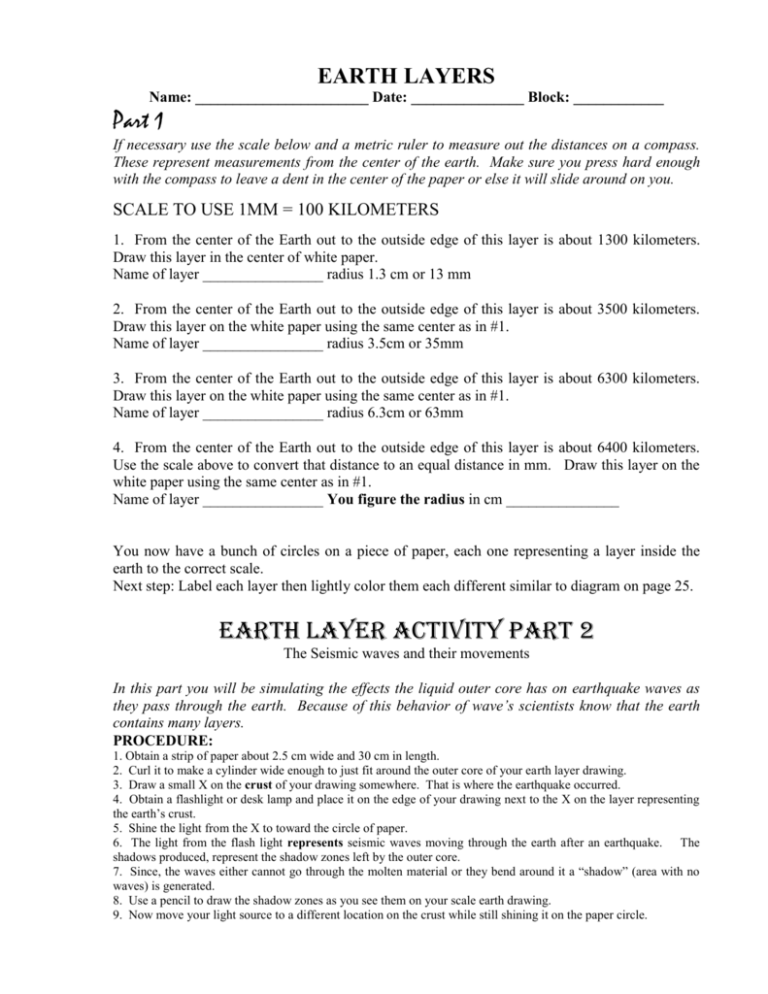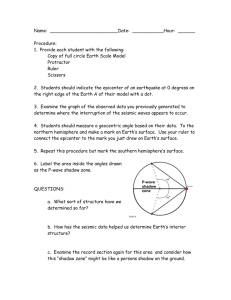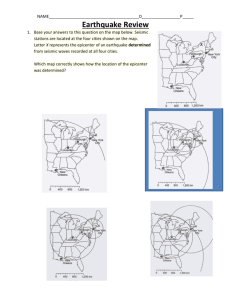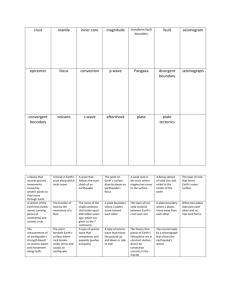EARTH LAYERS CUTOUTS
advertisement

EARTH LAYERS Name: _______________________ Date: _______________ Block: ____________ Part 1 If necessary use the scale below and a metric ruler to measure out the distances on a compass. These represent measurements from the center of the earth. Make sure you press hard enough with the compass to leave a dent in the center of the paper or else it will slide around on you. SCALE TO USE 1MM = 100 KILOMETERS 1. From the center of the Earth out to the outside edge of this layer is about 1300 kilometers. Draw this layer in the center of white paper. Name of layer ________________ radius 1.3 cm or 13 mm 2. From the center of the Earth out to the outside edge of this layer is about 3500 kilometers. Draw this layer on the white paper using the same center as in #1. Name of layer ________________ radius 3.5cm or 35mm 3. From the center of the Earth out to the outside edge of this layer is about 6300 kilometers. Draw this layer on the white paper using the same center as in #1. Name of layer ________________ radius 6.3cm or 63mm 4. From the center of the Earth out to the outside edge of this layer is about 6400 kilometers. Use the scale above to convert that distance to an equal distance in mm. Draw this layer on the white paper using the same center as in #1. Name of layer ________________ You figure the radius in cm _______________ You now have a bunch of circles on a piece of paper, each one representing a layer inside the earth to the correct scale. Next step: Label each layer then lightly color them each different similar to diagram on page 25. Earth Layer Activity Part 2 The Seismic waves and their movements In this part you will be simulating the effects the liquid outer core has on earthquake waves as they pass through the earth. Because of this behavior of wave’s scientists know that the earth contains many layers. PROCEDURE: 1. Obtain a strip of paper about 2.5 cm wide and 30 cm in length. 2. Curl it to make a cylinder wide enough to just fit around the outer core of your earth layer drawing. 3. Draw a small X on the crust of your drawing somewhere. That is where the earthquake occurred. 4. Obtain a flashlight or desk lamp and place it on the edge of your drawing next to the X on the layer representing the earth’s crust. 5. Shine the light from the X to toward the circle of paper. 6. The light from the flash light represents seismic waves moving through the earth after an earthquake. The shadows produced, represent the shadow zones left by the outer core. 7. Since, the waves either cannot go through the molten material or they bend around it a “shadow” (area with no waves) is generated. 8. Use a pencil to draw the shadow zones as you see them on your scale earth drawing. 9. Now move your light source to a different location on the crust while still shining it on the paper circle. QUESTIONS: 1. What happened to the shadow zones when the location of the earthquake changed? __________________________________________________________________________________________ __________________________________________________________________________________________ __________________________________________________________________________________________ 2. Explain how data of seismic waves from many earthquakes around the world tells us and helps us calculate the size of the outer core. _____________________________________________________________________________________________ _____________________________________________________________________________________________ _____________________________________________________________________________________________ 3. Considering that your earth drawing or model is to scale, what is the circular distance from the location of the earthquake to the beginning of the shadow zones? (see figure 2-3) ___________________________________ 4. Describe in as much detail as possible, what causes shadow zones. ____________________________________ _____________________________________________________________________________________________ _____________________________________________________________________________________________ 5. What is the composition of each of the different zones we discussed in class and approximately how thick are they? __________________________________________________________________________________________ __________________________________________________________________________________________ __________________________________________________________________________________________ __________________________________________________________________________________________ __________________________________________________________________________________________ 6. How much of the Earth’s mass is the inner core and outer core combined? ______________________________








